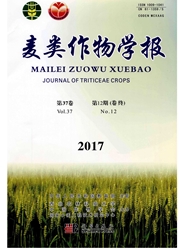

 中文摘要:
中文摘要:
为了探究预测小麦品质的方法,利用以小麦品种川农17与绵阳11为亲本构建的重组自交系群体为研究材料(共169个家系),分析了其籽粒性状和品质特性及二者之间的关系。结果表明,小麦粒长与降落值、面团形成时间和面团稳定时间呈极显著负相关,粒宽与沉降值、湿面筋含量和面筋指数呈极显著负相关,千粒重与降落值、沉降值、面团形成时间和面团稳定时间呈极显著负相关,容重与降落值、面团形成时间和面团稳定时间呈极显著正相关,与沉降值、湿面筋含量和面筋指数呈极显著负相关。粒长、千粒重和容重决定了降落值总变异的77.9%,粒长和千粒重决定了沉降值总变异的35.0%,容重和千粒重决定了面团形成时间总变异的50.7%,容重和千粒重决定了面团稳定时间总变异的49.3%,粒长、粒宽和容重决定了湿面筋含量总变异的51.0%,容重决定了面筋指数总变异的45.7%。说明在小麦品质育种中,粒长、粒宽、千粒重和容重可作为预测小麦品质优劣的选择指标。
 英文摘要:
英文摘要:
In order to explore the prediction methods of wheat quality, the correlation of grain traits and quality traits of wheat has been analyzed using a population of recombinant inbred lines(RIL), containing 169 lines obtained from a cross between Chuannong 17 and Mianyang 11. The correlation analysis indicated grain length is significantly negative correlated with falling number, dough develop ment time and dough stability time. Grain width is significantly negative correlated with sedimentation value, wet gluten content and gluten index. Thousand kernel weight is significantly negative correlated with falling number, sedimentation value, dough development time and dough stability time. Test weight is significantly positive correlated with falling number, dough development time and dough sta- bility time. However, test weight is significantly negatively correlated with sedimentation value, wet gluten content and gluten index. The multiple regression analysis indicated 77.9% of the total variance of failing number is decided by grain length, grain width and test weight. 35.0% of the total variance of sedimentation value is decided by grain length and thousand kernel weight. 50.7 % of the total variance of dough development time is decided by test weight and thousand kernel weight. 49.3% of the total variance of dough stability time is decided by test weight and thousand kernel weight. 51.0% of the total variance of wet gluten content is decided by grain length, grain width, and test weight. 45.7 ; of the total variance of gluten index is decided by test weight. Therefore quality traits of wheat can be selected based on grain traits, which could provide good theoretical guidance for further wheat breeding.
 同期刊论文项目
同期刊论文项目
 同项目期刊论文
同项目期刊论文
 期刊信息
期刊信息
